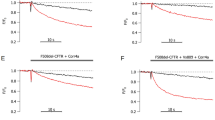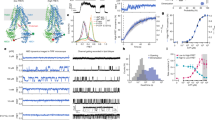Abstract
The cystic fibrosis transmembrane conductance regulator (CFTR) is a phosphorylation-regulated Ch− channel. In most mammalian cells, the functional consequences of the most common CF mutation, ΔF508-CFTR, cannot be assessed as the mutant protein undergoes biosynthetic arrest. However, function can be studied in the baculovirus-insect cell expression system where ΔF508-CFTR does not appear to undergo such arrest. Our results show that phosphorylation-regulated Cl− channel activity of ΔF508-CFTR is similar to that of wild-type CFTR. This observation was confirmed in comparative studies of purified ΔF508-CFTR and CFTR reconstituted in planar lipid bilayers. Therefore, we suggest that this Common mutation does not result in a significant alteration in CFTR function
This is a preview of subscription content, access via your institution
Access options
Subscribe to this journal
Receive 12 print issues and online access
$209.00 per year
only $17.42 per issue
Buy this article
- Purchase on Springer Link
- Instant access to full article PDF
Prices may be subject to local taxes which are calculated during checkout
Similar content being viewed by others
References
Tabcharani, J.A., Chang, X.-B., Riordan, J.R. & Hanrahan, J.W. Phosphorylation-regulated Cl− channel in CHO cells stably expressing the cystic fibrosis gene. Nature 352, 628–631 (1991).
Bear, C.E. et al. Purification and functional reconstitution of the cystic f ibrosis transmembrane conductance regulator (CFTR). Cell 68, 809–818 (1992).
Welsh, M.J. et al. Cystic Fibrosis Transmembrane Conductance Regulator: A Chloride Channel with Novel Regulation. Neuron 8, 821–829 (1992).
Kerem, B. et al. Identification of the cystic fibrosis gene: genetic analysis. Science 245, 1073–1080 (1989).
Cheng, S.H. et al. Defective intracellular transport and processing of CFTR is the molecular basis of most cystic fibrosis. Cell 63, 827–834 (1990).
Gregory, R.J. et al. Maturation and function of cystic fibrosis transmembrane conductance regulator variants bearing mutations in putative nucjeotide-binding domains 1 and 2. Molec. cell. Biol. 11, 3886–3893 (1991).
Denning, G.M., Ostedgaard, L.S. & Welsh, M. Abnormal Localization of Cystic Fibrosis Transmembrane Conductance Regulator in Primary Cultures of Cystic Fibrosis Airway Epithelia. J. cell Biol. 118, 551–559 (1992).
Kartner, N.K., Augustinas, O., Jensen, T.J., Naismith, A.L. & Riordan, J.R. Mislocalization of ΔF508 CFTR in cystic fibrosis sweat gland. Nature Genet. 5, 321–327 (1992).
Drumm, M.L. et al. Chloride conductance expressed by ΔF508 and other mutants in Xenopus oocytes. Science 254, 1797–1799 (1991).
Dalemans, W. et al. Altered chloride ion channel kinetics associated with ΔF508 cystic fibrosis mutation. Nature 354, 526–528 (1991).
Denning, G.M. et al. Processing of mutant cystic fibrosis transmembrane conductance regulator is temperature-sensitive. Nature 358, 761–764 (1992).
Bear, C.E., Jensen, T.J. & Riordan, J.R. Functional Capacity of the Major Mutant Form of the Cystic Fibrosis Transmembrane Regulator. Biophys. J. 61, A127 (1992).
Kartner, N. et al. Expression of the cystic fibrosis gene in nonepithelial invertebrate cells produces a regulated anion conductance. Cell 64, 681–691 (1991).
Vialard, J. et al. Synthesis of the membrane fusion and hemagglutinin proteins of measles virus using a novel baculovirus vector containing the ß-galactosidase gene. J. Virol. 64, 37–50 (1990).
Bear, C.E. & Reyes, E.F. cAMP-activated chloride conductance in the colonic cell line, Caco-2. Am. J. Physiol. 262, C251–C256 (1992).
Anderson, M.P. et al. Nucleoside triphosphates are required to open the CFTR chloride channel. Cell 67, 775–784 (1991).
Woodbury, D.J. & Miller, C. Nystatin-induced liposome fusion. A versatile approach to ion channel reconstitution into planar bilayers. Biophys. J. 58, 833–839 (1990).
Cutting, G.R. et al. A cluster of cystic fibrosis mutations in the first nucleotide-binding fold of the cystic fibrosis conductance regulator protein. Nature 346, 366–368 (1990).
Hyde, S.C. et al. Structural model of ATP-binding proteins associated with cystic fibrosis, mulitdrug resistance and bacterial transport. Nature 346, 362–365 (1990).
Hartman, J. et al. Recombinant Synthesis, Purification, and Nucleotide Binding Characteristics of the First Nucleptide Binding Domain of the Cystic Fibrosis Gene Product. J. biol. Chem. 267, 6455 (1992).
Thomas, P.J. et al. The Cystic Fibrosis Transmembrane Conductance Regulator. J. biol. Chem. 267, 5727–5731 (1992).
Laemmli, U.K. Cleavage of structural proteins during the assembly of the head of bacteriophage T4. Nature 227, 680–685 (1970).
Peterson, G.L. A simplification of the protein assay method of Lowry et al. which is more generally applicable. Anal. Biochem. 83, 346–356 (1977).
Hamill, O.P., Marty, A., Neher, E., Sakman, B. & Sigworth, F.J. Improved patch-clamp techniques for high-resolution current recording from cells and cell-free membrane patches. Pflugers Arch. 391, 85–100 (1981).
Riordan, J.R. et al. Identification of the Cystic Fibrosis Gene: Cloning and Characterization of Complementary DNA. Science 246, 1066–1073 (1989).
Kerem, B.-S. et al. Identification of mutations in regions corresponding to the two putative nucleotide (ATP)-binding folds of the cystic fibrosis gene. Proc natn. Acad. Sci. U.S.A. 87, 8447–8451 (1990).
Author information
Authors and Affiliations
Rights and permissions
About this article
Cite this article
Li, C., Ramjeesingh, M., Reyes, E. et al. The cystic fibrosis mutation (ΔF508) does not influence the chloride channel activity of CFTR. Nat Genet 3, 311–316 (1993). https://doi.org/10.1038/ng0493-311
Received:
Accepted:
Issue Date:
DOI: https://doi.org/10.1038/ng0493-311
This article is cited by
-
∆F508 CFTR interactome remodelling promotes rescue of cystic fibrosis
Nature (2015)
-
Targeting F508del-CFTR to develop rational new therapies for cystic fibrosis
Acta Pharmacologica Sinica (2011)
-
Exposure to sodium butyrate leads to functional downregulation of calcium-activated potassium channels in human airway epithelial cells
Pflügers Archiv - European Journal of Physiology (2006)
-
Targeted Therapy for Cystic Fibrosis
Molecular Diagnosis & Therapy (2006)



